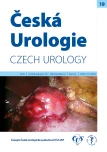LAPAROSCOPIC RESECTION OF KIDNEY TUMOURS
Authors:
Milan Hora 1; Viktor Eret 1; Petr Stránský 1; Tomáš Ürge 1; Tomáš Pitra 1; Kristýna Kalusová 1; Jiří Ferda 2; Ondřej Hes 3
Authors‘ workplace:
Urologická klinika, LF UK a FN Plzeň
1; Klinika zobrazovacích metod, LF UK a FN Plzeň
2; Šiklův ústav patologie, LF UK a FN Plzeň
3
Published in:
Ces Urol 2015; 19(2): 103-105
Category:
Video
Overview
Introduction:
This video presents our contemporary standard technique of laparoscopic resection (LR) of kidney tumours (KT), the method used most frequently by our group.
Material:
Between August 2004 and April 2015, we performed 274 LR. The surgical technique was continually developing along with the surgeons´ dexterity and usage of new technical accessories. At the same time, this surgical technique allowed for the treatment of a broader spectrum of KT, which are now managed using laparoscopic approach. This has gradually led to our management of KT with a higher R.E.N.A.L. nephrometry score (larger, more centrally or dorsally located lesions, and those affecting upper pole or hilus). There is an annual increase of KT managed by LR thanks to earlier diagnosis and an increased rate of detection of early (low) stage KT. In 2014, LR constituted 31.9 % of all surgically treated KT, amounting to 48 procedures.
Results – our technique:
The standard position is on the side with a transperitoneal approach using 4 ports (10mm, 2x5mm and 12mm). In select cases, an additional 5mm port on the right side is used for liver elevation with a grasper. Posterior peritoneum and Gerota´s fascia are opened. The tumour is detected and verified by a laparoscopic ultrasound probe (we define the borderline between tumour and parenchyma/renal sinus). After tumour verification, dissection of the renal hilar vessels is performed. Next the renal artery/arteries, or in rare instances only selected branch, are clamped using a laparoscopic bulldog endoclamp. In the case of tumour invasion into the sinus, we use a venous bulldog endoclamp to clamp the renal vein. In cases with a small extrarenal tumour we do not clamp the renal hilum. In cases with a complex renal hilum, where it is difficult to selectively dissect the vessel, it is possible to use extracorporeal clamping (inserted through the abdominal wall). This is followed by tumour resection into a healthy surgical margin using scissors. The specimen is inserted into the EndoCatch® Gold. In cases with a close resection margin, the resetected bed is managed by bipolar or Argon coagulation (the latter is contactless, but more expensive). The resected bed (vessels or opened collecting system) is sutured with Vicryl® or more recently V-Loc 90TM (both absorbable), with the sutures tightened with Hem-o-lok clipsTM ML. The same suture is used for closing of the parenchyma. Clips provide (even for V- LocTM) better tightening of kidney tissue and prevent the risk of kidney tearing. Hilar vessels are than released. Possible residual bleeding is managed by another suture or sometimes covered by oxidized cellulose. Suturing of the posterior peritoneum and Gerota´s fascia is done with V-Loc 90TM. An easyflow drain is placed through lateral 5mm port. The specimen is removed through incision of the 12mm port, which is slightly enlarged. The specimen margin is marked black for the pathologist.
Conclusion:
LR is a standardized method that enables us to treat almost one third of kidney tumours.
Key words:
Kidney tumour, renal carcinoma, resection, laparoscopy.
Sources
1. Hora M, Klečka J, Ürge T, Ferda J, Hes O, Eret V. Laparoskopická resekce tumorů ledvin (Laparoscopic resection of renal tumours), Ces Urol 2006; 10(1): 32–39.
2. Hora M, Eret V, Ürge T, et al. Results of laparoscopic resection of kidney tumour in everyday clinical practice, CEJU (Central European Journal of Urology), 2009; 62(3): 160–166.
3. Hora M, Eret V, Stránský P, et al. Evoluce operační techniky laparoskopické resekce nádorů ledvin (Evolution of surgical technique of laparoscopic resection of kidney tumors), Ces urol 2010; 14(1): 24–31.
Labels
Paediatric urologist Nephrology UrologyArticle was published in
Czech Urology

2015 Issue 2
Most read in this issue
- NEW TRENDS IN RENAL ANGIOMYOLIPOMAS THERAPY
- LIPOSARCOMA AND GANGLIONEUROMA AS PRIMARY RETROPERITONEAL TUMOURS
- TUMOR GLANS AS A CLINICAL MANIFESTATION OF PLASMABLASTIC LYMPHOMA
- PHYSIOTHERAPY IN TREATING URINARY INCONTINENCE IN WOMEN
